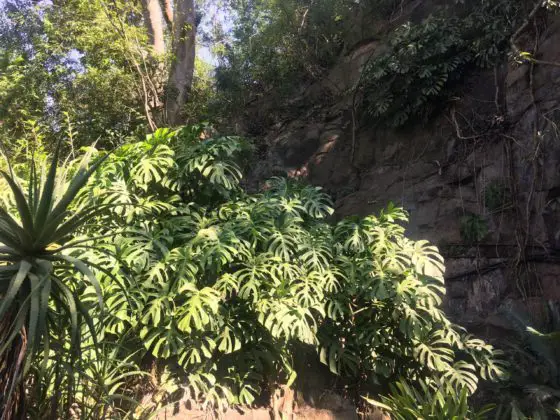Monstera Albo in the wild? Yes, it exists! If you’ve ever wondered about this majestic plant’s natural habitat, you’re in for a treat. Monstera Albo, with its mesmerizing variegated leaves, thrives in the lush tropical rainforests of Central and South America. This elusive beauty, known for its striking white markings, is a sight to behold in its wild surroundings.
Join me as we embark on a journey into the untamed world of Monstera Albo, discovering its natural allure and uncovering the secrets of its remarkable adaptation. Get ready to be captivated by the sheer magnificence of Monstera Albo in the wild.
Monstera Albo in the Wild
Monstera Albo, also known as Variegated Monstera or Monstera deliciosa Albovariegata, is a stunning and highly sought-after plant known for its unique variegated leaves. In recent years, it has gained tremendous popularity among plant enthusiasts and collectors.
While it is commonly seen as a houseplant, Monstera Albo can also be found in the wild, thriving in its natural habitat. In this article, we will dive into the world of Monstera Albo in the wild, exploring its origins, growth habits, and the unique characteristics that make it a fascinating plant to study.
Origins and Habitat
Monstera Albo is native to the tropical rainforests of Central and South America. Although it is commonly found in regions like Costa Rica, Panama, and Colombia, its exact natural habitat can vary.
This plant is an epiphyte, meaning it grows on other plants and uses them for support, without taking nutrients from them. In the wild, Monstera Albo thrives in the dense undergrowth of the rainforest, often climbing trees to reach sunlight.
Growth Habits
In its natural habitat, Monstera Albo can grow to impressive heights, with some specimens reaching up to 70 feet. The plant begins its life on the forest floor, where it germinates from seed. As it matures, it develops long aerial roots that help it climb trees.
These aerial roots have the ability to attach themselves to rough surfaces, allowing the plant to anchor itself securely. Once it reaches a suitable spot with access to sunlight, the plant sends out large, fenestrated leaves that are characteristic of the Monstera genus.
Foliage and Variegation
One of the most striking features of Monstera Albo is its variegated foliage. Unlike the typical Monstera deliciosa, which has dark green leaves, Monstera Albo displays stunning variations of white or cream-colored patches on its leaves.
This variegation is the result of a mutation that causes certain parts of the leaf to lack chlorophyll, the pigment responsible for green coloration. The absence of chlorophyll in these areas gives rise to the unique and highly sought-after variegated pattern.
The level of variegation can vary greatly between individual plants, as each leaf has its own distinct pattern. Some Monstera Albo plants may exhibit only a few small patches of variegation, while others can have leaves that are almost entirely white.
The high variability adds to the allure and rarity of this plant, making it a prized possession for many collectors..
Read More: About Can You Smoke Weed Right Off The Plant? Exploring The Possibilities
Challenges and Adaptations in the Wild
Surviving in the wild can be challenging for any plant, and Monstera Albo is no exception. However, this striking plant has evolved unique adaptations to thrive in its natural environment. Here are some of the challenges Monstera Albo faces in the wild and how it overcomes them:
Low Light Conditions
In the dense rainforest understory, sunlight is often limited. Monstera Albo has adapted to these conditions by developing large leaves with deep fenestrations. The holes in the leaves allow sunlight to penetrate deeper into the foliage, maximizing the plant’s ability to photosynthesize and produce energy.
Competition for Resources
Being an epiphyte, Monstera Albo relies on other trees for support. However, this also means that it competes with other plants for essential resources such as water and nutrients. To overcome this challenge, Monstera Albo has developed a robust root system with aerial roots that not only anchor the plant but also absorb moisture and nutrients from the air and surrounding debris.
Adaptation to Climbing
Climbing trees is essential for Monstera Albo to reach sunlight. The plant’s aerial roots have a unique ability to cling to rough surfaces, providing stability as it ascends towards the canopy. Additionally, the aerial roots can grow and adapt to the bark texture of different tree species, further enhancing the plant’s ability to climb and thrive.
Conservation Efforts
The growing popularity of Monstera Albo has led to increased demand from plant enthusiasts and collectors. Unfortunately, this demand has resulted in illegal poaching and overcollection from the wild, threatening the plant’s natural populations. To protect Monstera Albo and its habitat, conservation organizations and governmental agencies have implemented various strategies, including:
– Creating protected areas and national parks to preserve the natural habitats where Monstera Albo is found.
– Implementing stricter regulations and laws to prevent illegal collection and trade of Monstera Albo specimens.
– Encouraging sustainable cultivation and propagation of Monstera Albo through controlled environments such as botanical gardens and nurseries.
These conservation efforts aim to ensure the long-term survival of Monstera Albo in the wild and prevent the depletion of its natural populations.
Monstera Albo is a captivating plant both in its natural habitat and as a houseplant. Its variegated foliage, climbing abilities, and adaptations to the wild make it a fascinating subject for study and admiration.
However, it is crucial to remember the importance of responsible collection and cultivation to protect this unique plant from overexploitation. By appreciating Monstera Albo’s beauty and understanding its role in the ecosystem, we can contribute to its continued existence in the wild for future generations to enjoy.
Read More: About Do Tomato Plants Die After Harvest
Frequently Asked Questions (FAQs)
Monstera Albo, also known as Variegated Monstera or Variegated Swiss Cheese Plant, is a popular tropical plant characterized by its unique variegated leaves. It features stunning white or cream-colored patterns on its dark green foliage.
Monstera Albo is native to the rainforests of Central and South America, including countries like Mexico, Panama, and Colombia. It primarily grows as an epiphyte, climbing on trees or other supports to reach sunlight.
In the wild, Monstera Albo has evolved to adapt to its surroundings. Its holes or fenestrations allow wind to pass through, preventing its large leaves from being damaged during storms. The variegation helps the plant capture more sunlight in the often-shaded rainforest.
Monstera Albo is a tropical plant and thrives in warm and humid environments. It is not suitable for outdoor cultivation in non-tropical regions, as it is highly sensitive to cold temperatures. It is best grown indoors in a controlled environment.
Monstera Albo requires a moist and well-draining soil mix in its natural habitat. It prefers bright, indirect sunlight and high humidity levels. Regular watering and occasional misting can help maintain the ideal conditions for its growth.
Yes, Monstera Albo can be propagated in the wild through various methods such as stem cuttings or air layering. Natural factors like fallen branches or damaged vines can provide opportunities for the plant to reproduce and establish new growth.
Like any other plant, Monstera Albo is susceptible to pests and diseases. Common pests include spider mites, mealybugs, and scale insects. Fungal diseases such as root rot can also occur if the soil is overly wet. Regular inspection and appropriate pest management techniques are essential for its health.
Monstera Albo is not considered endangered in the wild. However, due to its popularity in the horticultural trade, unsustainable collection and habitat destruction pose threats to its long-term survival.
It is important to support responsible sourcing and cultivation practices to conserve this species in its natural habitat.
Final Thoughts
Monstera albo, a stunning variegated plant, can also be found in its natural habitat, the wild. In the wild, Monstera albo exhibits its unique and mesmerizing beauty. With its striking white variegation contrasting against deep green leaves, Monstera albo stands out among other plants. The rare and coveted Monstera albo in the wild is truly a sight to behold.
Whether it is found climbing up trees or sprawling along the forest floor, Monstera albo brings a touch of elegance to its surroundings. Monstera albo in the wild serves as a reminder of the immense diversity and beauty that nature has to offer.
Auto Amazon Links: No products found.
Perfect Plants Christmas Tree Saver 8oz. | Easy Use Xmas Tree Preserver Food | Have Healthy Green Christmas Trees All Holiday Season
$9.97 (as of December 13, 2025 05:07 GMT +00:00 - More info- Product prices and availability are accurate as of the date/time indicated and are subject to change. Any price and availability information displayed on [relevant Amazon Site(s), as applicable] at the time of purchase will apply to the purchase of this product.
Rocky Mountain Goods Christmas Tree Food - 8 oz Tree Preservative - Reduce Needle Drop - Greener Scent - Fir, Pine, Spruce Trees - Extend Tree Life
$9.95 (as of December 13, 2025 05:07 GMT +00:00 - More info- Product prices and availability are accurate as of the date/time indicated and are subject to change. Any price and availability information displayed on [relevant Amazon Site(s), as applicable] at the time of purchase will apply to the purchase of this product.
FirEver Pure Christmas Tree Food | Preserver Additive & Season Extender for Live Xmas Trees | Keep It Green, Reduce Needle-Drop | Miracle Freshness (8 oz)
$14.99 (as of December 13, 2025 05:07 GMT +00:00 - More info- Product prices and availability are accurate as of the date/time indicated and are subject to change. Any price and availability information displayed on [relevant Amazon Site(s), as applicable] at the time of purchase will apply to the purchase of this product.
VICAMB 39.3 Inch Christmas Tree Watering Funnel,Christmas Tree Watering System Device,Long Tree Watering Funnel Spout for Indoor Outdoor Xmas Tree
$16.99 (as of December 13, 2025 05:07 GMT +00:00 - More info- Product prices and availability are accurate as of the date/time indicated and are subject to change. Any price and availability information displayed on [relevant Amazon Site(s), as applicable] at the time of purchase will apply to the purchase of this product.
EZMeetU Christmas Tree Watering Funnel, 47 Inch Flower Shape Adjustable 6 Section Design, Christmas Tree Watering System, Christmas Tree Waterer, Long Funnel Wide Opening Reusable, Plant Watering Tool
$16.99 (as of December 13, 2025 05:07 GMT +00:00 - More info- Product prices and availability are accurate as of the date/time indicated and are subject to change. Any price and availability information displayed on [relevant Amazon Site(s), as applicable] at the time of purchase will apply to the purchase of this product.
Snow Joe Premium Enviro Blend Ice Melt, Green-Coated Deicer Crystals, 50 lb - Safer Melter for Vegetation, Concrete & Metals w/ Anti-Corrosion Calcium Magnesium Acetate
$32.97 (as of December 12, 2025 19:27 GMT +00:00 - More info- Product prices and availability are accurate as of the date/time indicated and are subject to change. Any price and availability information displayed on [relevant Amazon Site(s), as applicable] at the time of purchase will apply to the purchase of this product.
Muddy Mat® Shown on TV Super Absorbent Microfiber Dog Door Mat for Muddy Paws, Non-Slip Washable Pet Rug, Quick Dry Chenille Entryway Carpet, Machine Washable Indoor Outdoor mat, Grey 30"x19"
$24.95 (as of December 12, 2025 19:27 GMT +00:00 - More info- Product prices and availability are accurate as of the date/time indicated and are subject to change. Any price and availability information displayed on [relevant Amazon Site(s), as applicable] at the time of purchase will apply to the purchase of this product.
ivtivfu Rolling Grill Basket, Removable Wooden Handle, 304 Stainless Steel, Nesting BBQ Tools, Smoker Grilling Accessories for Vegetable, Outdoor Cooking Camping, Birthday Gifts for Men Dad Husband
$25.99 (as of December 12, 2025 19:27 GMT +00:00 - More info- Product prices and availability are accurate as of the date/time indicated and are subject to change. Any price and availability information displayed on [relevant Amazon Site(s), as applicable] at the time of purchase will apply to the purchase of this product.
XXXFLOWER Plant Terrarium with Wooden Stand, Air Planter Bulb Glass Vase Metal Swivel Holder Retro Tabletop for Hydroponics Home Garden Office Decoration - 3 Bulb Vase
$18.98 (as of December 12, 2025 19:27 GMT +00:00 - More info- Product prices and availability are accurate as of the date/time indicated and are subject to change. Any price and availability information displayed on [relevant Amazon Site(s), as applicable] at the time of purchase will apply to the purchase of this product.
Zevo Flying Insect Trap Official Refill Cartridges - Fits Both Zevo Trap & MAX Indoor Fly Trap - Authentic Trap+Lock Technology to Catch Gnats, House & Fruit Flys (4 Official Refill Cartridges)
$14.97 (as of December 12, 2025 19:27 GMT +00:00 - More info- Product prices and availability are accurate as of the date/time indicated and are subject to change. Any price and availability information displayed on [relevant Amazon Site(s), as applicable] at the time of purchase will apply to the purchase of this product.











